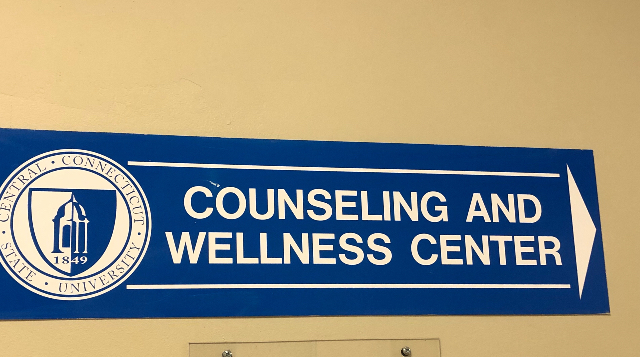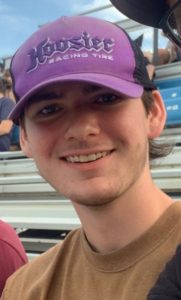Health Center Reduces Wait For Counseling Appointments
The Counseling and Wellness Center located in Willard-DiLoreto Hall.
April 10, 2019
This article was first published on Central Connecticut’s Journalism Department’s Focus Mental Health site, FMHnews.com, and is being republished in The Recorder with FMH’s permission.
As recently as last semester, students at Central Connecticut with mental health complaints were waiting as long as two months to get an appointment with counselors.
The time between requests and appointments has been significantly reduced with expanded space and some staff addition, but extended waits continue.
“When students call the first time to set up an appointment, the receptionist will ask you three questions: ‘Are you thinking about hurting yourself or others, are you suicidal or are you hearing any voices that other people are not?’ This is to see which students need urgent help,” Jonathan Pohl, coordinator of Wellness Education, said.
Sophomore Armando Osorio experienced the problem with delays last fall, when the center had just three full-time counselors.
“I got in immediately [last semester] because I answered yes to those questions. I had a panic attack and I knew I needed help. But if you answer no to one of those questions, they are going to say, ‘Okay, it’s going to be a month,'” Osorio shared.
The long wait had Osorio frustrated because she was not always able to see the same counselor.
“I need to be seen once a week and I haven’t been able to get that because their [appointments] are a month out. I shouldn’t have to be in a dangerous situation with myself to get help, ” Osorio said.
Sophomore Meghan Tooth dealt with a similar problem, having wanted to be seen by a counselor, but told she had to wait almost two months to get in.
“I answered no to all three questions because I don’t feel that way. However, it is also annoying because it sort of makes you feel like your problems aren’t important enough to them,” Tooth stated.
With the move to Willard-Diloreto, the new space will offer more room for counselors. Pohl will be located in the new building, allowing him to see students where it is more convenient. An intern could not be added to the staff last fall because of spacing issues. As of now, the counselors remain in Marcus White.
The need for counselors has risen due to the high demand of students needing to seek services. Although the Wellness Center cannot quantify the precise number as of now, counselors say they have seen a huge increase in recent years.
In a January 2018 article by Focus Mental Health, the Center provided numbers indicating that there was a 49 percent increase in the number of students who received counseling services from 417 to 622 unique visitors, from the 2014-’15 academic year to 2015-’16.
Pohl realizes that being short-staffed last year has “made it harder for students who aren’t in need of urgent care to be seen,” and is aware of the rising numbers from noticing that Student Wellness Center has been “very busy.”
Central should have at least eight counselors, according to standards set by the International Association of Counseling Services, the accreditation for universities, four-year colleges and two-year community college counseling services. The standard is one counselor per 1,000 to 1,500 students. Central is just under 12,000 students.
Two new part-time counselors and one new full-time counselor have been hired and are set to start in April, bringing the staff to three part-time counselors and four full-time. With the additional staff, Central still does not meet the criteria set by the International Association of Counseling Services.
The hiring of two part-time counselors fell through because of the lengthy hiring process due to background checks, which can take between 3-6 months, and they eventually found other work, according to Pohl. Not having the two part-time counselors was one of the driving factors behind the long wait list.
The wait time has currently gone down, according to Associate Director Of Student Wellness Services Dr. Shannon Jackson.
“We are currently at less than two weeks wait time on average and we have an open intake slot or two open this week,” he stated. “However, students in crisis are seen immediately.”
“My estimation is that we currently have somewhat shorter wait time than we did at this point last year. To determine this definitively would require a bit of number crunching,” Jackson continued. “We typically do our data analysis during the summer after the conclusion of the academic year. My estimation is that we will end up seeing more students this year than last.”
Osorio stated she is “really happy” with the improvements being made and noted she plans to seek services again soon.
Last semester, since the counseling services were very short-staffed, group therapy was a way to get students seen more quickly. Sophomore Megan Colleran dealt with this issue when she was a freshman. After the death of her father, her family members called to get Colleran seen by a Central counselor. After her first meeting, Colleran was placed into group therapy.
Group therapy on campus is not by topic. Students can be placed into a group of people with completely different issues as long as they show no signs of social anxiety.
“I had a different need than the other students in the group. I almost felt bad sometimes bringing up the issue that I had because the other people were like, ‘Oh, my parents are fighting,’ or, ‘I’m having trouble with homework,’ and then when I say what I’m dealing with, I felt just bad.”
Colleran was never told why she was placed into group therapy. Her family members were also upset by the decision, but Colleran stated that she wanted to “give it an honest try.”
“I think it would have been more effective if I was placed with people who were in similar situations. I don’t feel like [ my group] was appropriate for me. I felt like I was on a different playing field in terms of the help that I needed to get.”
Colleran stopped going to counseling at Central, which was her first and only experience with counseling services thus far. However, Colleran is “hoping to explore local [counseling] offices, once I’m home for the summer,” she stated.
According to Jackson, “group therapy is available to students as soon as they complete an initial individual appointment with a counselor.”
“It’s a great intervention for many concerns that students present with. It is not appropriate for everyone, however,” he said.
Jackson also noted that entering group therapy is a decision the student and counselor make together. In addition to being an effective method to address student concerns, group therapy shortens the time between the initial appointment and entry into therapy for most students.
There are walk-in times for students to see counselors starting at 8 a.m.; however, counselors are not on a caseload schedule, which means they do not have a set number of students to see. They can see a large number one day and fewer the next.
Tooth, a transfer student from Eastern Connecticut and the University of New Haven, both with smaller student populations, said she noticed a big difference in counseling services between the schools.
“[At Eastern], you were able to see a counselor the day you called. [At Central], I called around Oct. 25 [last year] and they told me the first available appointment was for December 25. I needed someone to talk to then, not two months later,” she said.
Even with the new staff and reduced wait times, Tooth is not fully satisfied with the amount of change that has happened.
“I think two weeks is still a long wait to get a first appointment. I think they should have more walk-in hours for people that really need it,” Tooth stated.






